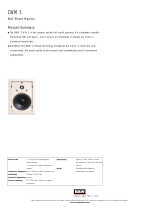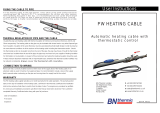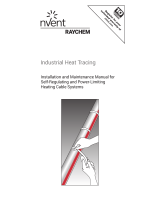
4
appropriate voltage coil shall be connected in parallel prior
to the heat tracing (should show figure with typical installa-
tion). The output contacts of the listed power supervisory relay
should be connected to a listed fire control panel which has
provisions for supervisory circuits.
6. Do not attempt to heat trace any piece of equipment
which will not be insulated.
7. Do not install heating cable on equipment which
could become hotter than the heating cable’s maxi-
mum exposure temperature.
8. Do not install heating cable in an area or on equip-
ment which contains potentially corrosive materials
without having a suitable protective jacket on the
cable.
9. The minimum bending radius for all Chromalox
heating cables is six times the minor diameter.
10. Allow a minimum of 2” between cable runs.
11. Always install heat tracing on the outside radius of
elbows.
12. Never install heat tracing over expansion joints
without leaving slack in the cable.
13. Never use tie-wire or pipe straps to secure Self-
Regulating Maximum Circuit length or Constant
Wattage heating cables.
14. Observe all published specifications. Do not expose
cables to temperatures above their specified maxi-
mums. Do not run cables longer than specified max-
imum circuit lengths. See table 3 for details.
15. Pumps and small vessels should be heat traced and con-
trolled with the piping on the inflow end. The cable on the
pump or vessel should be physically separate to permit dis-
connection during maintenance or removal.
16. Use aluminum foil tape to cover the heating cable whenever
the cable is not in good contact with the pipe (i.e. at supports,
valves, pumps, etc.) or whenever its use is specified by the
“Chromalox Design Guide for Heat Tracing Products”.
17. Separately controlled circuits should be provided on dead end
legs and closed bypasses.
18. No heat tracing circuit should extend more than two feet be-
yond a point where two or more pipes join when such junc-
tions permit optional flow paths. In such cases, separately
controlled traces should be used.
19. The minimum installation temperature for all Chromalox heat-
ing cables is -76˚F (-60˚C).
20. Chromalox Type SRL heating cables are well suited for heat
tracing plastic pipes. Consult “Chromalox Design Guide for
Heat Tracing Products” for design recommendations. Installa-
tion details AD1 through AD17 apply for plastic pipe only when
Type SRL heating cable is used. Consult factory for applica-
tions involving other products.
B. INSTALLING A SINGLE RUN OF CABLE ON A PIPE.
1. Mount the reel of cable on a holder and place near one end of
the pipe run to be traced. Choose the end from which it will be
the easiest to pay out the cable.
2. Pay out the cable from the reel and loosely string along the
piping, making sure the cable is always next to the pipe when
crossing obstacles. For example, if the heater is on the wrong
side of a crossing pipe, you will have to restring the cable or
cut and splice it.
To prevent damage to cable, avoid such things as:
— Pulling the cable over sharp edges.
— Forcibly pulling the cable free if it snags while
being paid out.
— Allowing the cable to be walked on or subjec-
ed to other abuse which could cause mechan-
ical damage.
3. When you reach the end of the circuit, secure the heater cable
to the pipe using glass tape or plastic cable tie with a tem-
perature rating compatible with the heater cable.
If this end is to have an end seal installed, remember to leave
about a foot of extra cable. If it is a power connection, leave
about two feet of extra heater cable.
4. (If the heater cable is to be spiralled, go to step 4A.)
Begin attaching the cable to the pipe about every foot (.3 me-
ters).
Place the cable on the bottom half of the pipe at the 5 or 7
o’clock position. Refer to installation detail AD1. Go to step 5.
a. Note the path of the heater cable and the spiral factor of
the design. A simple way to think about spiral factor is:
A1.1 spiral factor means install 11 feet of heating cable on
every 10 feet of pipe, etc. At about every 10 feet of pipe,
pull the required amount of cable and let hang in a loop,
and attach the cable to the pipe.
b. Rotate the loops around the pipe until all the slack has
been taken up. Even out the spirals of the heater cable and
secure to the pipe as necessary to obtain good contact.
The entire circuit can be installed with hanging loops with
the spiralling on the pipe being done when you trace the
heat sinks. Refer to installation detail AD3.
5. At a heat sink (pipe supports, valves, pumps, reducers, gaug-
es, bucket strainers, etc.), attach the heater cable to the pipe
just before the heat sink. Refer to the design specs to deter-
mine the amount of heater cable you need to install on the
heat sink. Pull this amount of cable into a loop, attach the
heater cable on the other side of the heat sink and continue
attaching the cable down the pipe as before.
6. When you reach the heater cable reel, you should have the
heater cable attached all along the pipe, with the correct
amount of heater cable pulled in loops at all heat sinks. Attach
the cable to the pipe, (leave an extra foot if at an end seal, two
feet if at a power connection) and cut the heater cable from
the reel.
7. Install the heater cable loops on the heat sinks. Refer to the
proper installation detail (AD5-AD12) for a general idea of how
to install the cable, but remember:
• It is important to get the proper amount of heater cable on
the heat sink, rather than exactly as the detail shows. The
detail is just a guide.
• Self-Regulating heater cables are very flexible and can be
single overlapped for installation ease. Feel free to use this
feature when you can.
FIRE HAZARD. Do not overlap constant wattage or min-
eral insulated heating cables.
• By having the cable installed this way, it can be removed
easily from the heat sink without cutting if access to, or
removal of the heat sink is required.
Note: If a tee is designed into the system, or if you are using two
or more short cable lengths to complete a circuit, allow two or
three feet of each cable to overlap. This will allow flexibility in as-
sembling the connection kit and locating it on the pipe.
C. INSTALLING MORE THAN ONE HEATING CABLE ON A
PIPE.
There are two cases where you will need to install more than one
heater cable on a pipe:
• When the design calls for more than one cable.
•
When the lines being heat traced are considered important
enough to install a backup (redundant) heat tracing system.


















